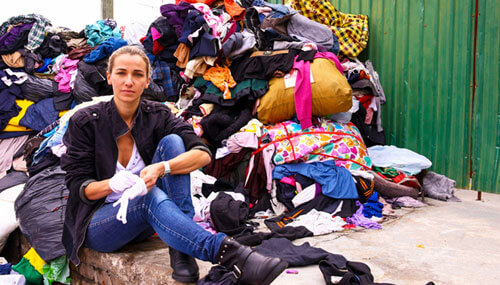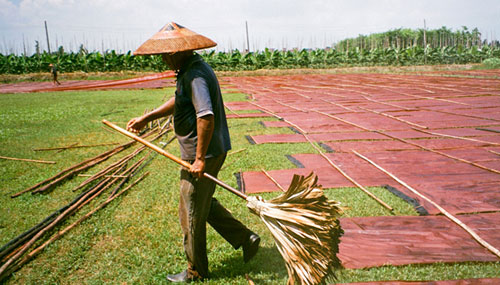US-Asia Business
Towards a More Sustainable U.S.-China Fashion Industry
By Angela Bao

Fashion entrepreneurs explore ways to source sustainably made materials from China.
In a small village along the Pearl River in China’s Guangdong Province, a group of straw-hatted people carry bundles of reddish brown silk, and lay them flat in a grassy field to bake under the sun. It may look innocuous, but the sunbaking is an integral process to treating the silk, and giving it its unique durability and airiness. The silk is called xiang yun sha (香云纱), which roughly translates to “perfumed cloud clothing,” that stems from 500 years of Chinese tradition. The process for dyeing and treating the silk eschews any chemicals or machines; it involves only the earth, man and the sun. It’s a completely sustainable process, and also the foundation of Los Angeles, Calif.-based clothing brand Ziran.
For founder Kelly Wang Shanahan, sustainability and cultural heritage are the two driving factors for starting Ziran, as well as showing people that it’s possible to get sustainable textiles from China. “The sustainability of this silk is an added benefit to the cultural legacy of the [silk-making] process,” says Shanahan. “I’m Chinese, so I also want to show people that ‘Made in China’ is something to be proud of.” Ziran is one of numerous fashion companies, large and small, that are currently championing the sustainable fashion movement and trying to source responsibly-made materials from China. Although people think that sustainability comes at the cost of growth and profitability, fashion giants like H&M Group demonstrate otherwise. When H&M first launched its eco-friendly Conscious Collection in 2011, they had just over 2,400 stores worldwide and almost 191 billion SEK ($21.2 billion) in sales; after introducing a clothes-recycling initiative in 2013 and outlining an ambitious sustainability plan, they almost doubled the number of stores to over 4,300 and made 222.8 billion SEK (about $24.8 billion) by the end of 2016.
A more sustainable China
H&M does not own any of its own factories—it relies on a network of independent suppliers and factories around the world, a large portion of which are in China. Although China is not currently known for its environmentally friendly manufacturing, stricter monitoring from Western corporations to ensure compliance with their own sustainability initiatives and tighter environmental regulations from the Chinese government are turning the textile tide.
Christina Dean, founder and board chair of Redress, an environmental nonprofit organization working to reduce waste in the fashion industry, says that China is actually rapidly improving in its sustainable textile offerings. “The major textile fairs in China now have more sustainable textile suppliers and materials on offer, dedicated zones and exhibits of innovative textiles, and seminars on the topic,” notes Dean. “All of these things indicate increased appetite from buyers and producers.”

"Creating high-tech, durable textiles that require less energy and water input, and the using of innovative materials, requires intellect, infrastructure and capital investment, which you won’t find in developing countries."
Along with the shifting focus to greener manufacturing, China’s existing supply-chain infrastructure makes it competitive against lower-cost nations. Although companies are shifting some manufacturing to countries in Southeast Asia, China still comes out on top when it comes to efficiency. “Because China is so well-established as an export and manufacturing country, the logistics of doing business there has been extremely efficient,” says Shanahan. “I’m relatively small-scale, but shipping products to the U.S. has been super easy; it takes only about one week to send.”
Shanahan also inserts that WeChat, China’s main social media app, has drastically streamlined the process of doing business across the Pacific. “We conduct most of our business over WeChat,” she says. “Whenever I need to send them a new fabric print, I turn it into a JPEG and send it directly to the manufacturer over WeChat. That’s all they need: just a WeChat photo. Even with the language barrier, communicating has been really easy. There’s a translate function on WeChat that instantly translates what you’re writing. It’s not perfect, but you still understand what they’re saying.”
Dean adds that China is primed for efficient, cost-effective sustainable manufacturing. “Price may still be king in fashion, but so, too, is stability within the supply chain, given fashion’s razor timeliness, tight margins, and increasing demand for transparency. With this in mind, China will remain on her production pedestal,” Dean predicts. “Creating high-tech, durable textiles that require less energy and water input, and the use of innovative materials require intellect, infrastructure and capital investment, which you won’t find in developing countries.”
Finding the right sources
For fashion labels that are looking to integrate sustainability into their own supply-chain, Richard Brubaker, founder of strategic advisory firm Collective Responsibility that specializes in sustainable business practices, suggests that the first step is to focus on one thing. “Find the waste—it can be a process, a material, energy, etc. Attack it, and take the money saved and invest that into the next step,” advises Brubaker.
"Find the waste…Attack it, and take the money saved and invest that into the next step."

For young fashion entrepreneurs, another option is to repurpose “waste” materials. Dean, who also cofounded upcoming, luxury fashion line BYT, upcycles leftover fabrics from manufacturers and partners to create BYT’s clothes. “‘Waste’ comes in many shapes and sizes that includes end-of-rolls from manufacturers or damaged fabrics,” says Dean. According to Dean, China generates 26 million tons of textile waste each year, so the upcycling options are plentiful. “One guiding principle that we should all have is that ‘waste is not waste until it is wasted,’” she adds.
For Shanahan, she did her research and went back centuries into China’s history to find the right sustainable textile for Ziran. “It’s a 500-year-old process, and obviously 500 years ago they didn’t have pesticides and toxins to treat the silk,” quips Shanahan. It also doesn’t hurt that the Chinese government is putting efforts into bringing the silk back into the mainstream. Although Ziran silk is steeped in cultural heritage, Shanahan says production of it all but stopped during the Cultural Revolution and only resurfaced about 15 years ago. “They [the local government] just built a museum in Guangdong dedicated to xiang yun sha,” says Shanahan. “Most young people don’t know about it—that’s part of the reason why the government is trying to promote it as ‘one of China’s cultural treasures.’” Plus, increased demand and production would ultimately lower Shanahan’s costs and drive up her profits.

"The future of China’s textile industry will be cleaner and more circular."
Opportunities in higher-end manufacturing
With the recent beefing-up of environmental regulations and its Made in China 2025 initiative, the country is making a concerted effort to move away from low-end manufacturing. With its efficient and well-developed infrastructure, skilled workforce, and innovation-driven growth, China may be a good fit for some higher-end fashion brands trying to be sustainable, yet keep costs low and quality high. Certainly, both BYT and Ziran fall in that category. Lane Crawford, a Hong Kong-based luxury fashion retailer, will stock BYT’s first collection, and Ziran’s prices typically range from $345 for a blouse, to $800 for a bomber jacket. “Fast fashion in China has had its moment,” notes Dean on the changes in China’s manufacturing industry. “The future of China’s textile industry will be cleaner and more circular, i.e. regenerative.”
Sign up for the Reach Further Newsletter
We’ll keep you in the know about the latest US-Asia business news and trends.
Suscríbase al boletín Reach Further
Lo mantendremos informado sobre las últimas noticias y tendencias comerciales entre Estados Unidos y China.

